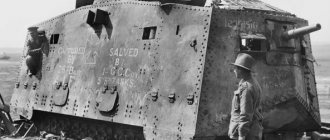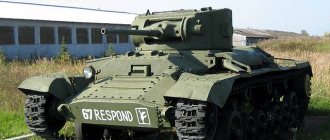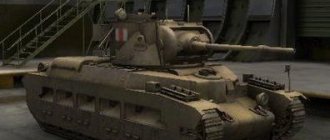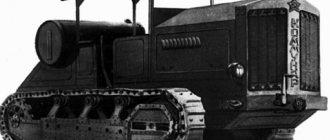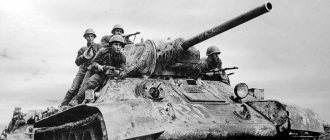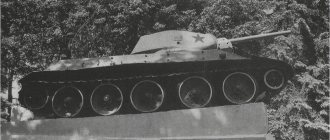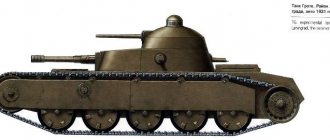Tank Matilda II (full name Tank Infantry Mk. II Matilda II) is a British medium tank with heavy armor from the Second World War. The vehicle was widely used by the British army during military operations in Africa. It is also one of the most famous foreign-made tanks that were used by the Red Army during World War II.
Historical information
Back in the mid-30s, the military leadership of England came up with the idea of strengthening the armor of their tank fleet, because at that time it was extremely weak. In 1936, the development of a new tank with frontal armor of at least 60 mm began.
The brief heroic history of the tank began in 1936-1938, when it was created to replace the existing Matilda I. It was put into service at the beginning of World War II and began entering service with the troops in 1939.
Matilda II was the main medium tank in England at the initial stage of the war. The tank was produced until August 1943 at 7 British factories. A total of 2,987 units were produced, of which 1,084 became “lend-lease” for the USSR. Of the total number, 918 units were delivered to the shores of the USSR.
Also, a large number of Mark-2 tanks, removed from the linear units of the royal army, took part in the battles in the Pacific Islands on the side of Australia.
This is interesting: the tank received its name from the previous generation vehicle Matilda I, which, in turn, received it from the comic book heroine Matilda the duck.
At the time, the MK-IIs were distinguished by very powerful armor and a pretty good gun. The German standard Pak 36 cannon, 37 mm caliber, could not cope with the armor of this vehicle. It was susceptible only to an 88-mm anti-aircraft gun. Therefore, the tank was a formidable opponent for German armored vehicles in the first stages of hostilities.
Medium infantry tank Mk II A "Matilda"
Tank Infantry Mk II Matilda II.
The Matilda tank was developed in 1939 and was mass-produced from 1940 to 1943. The tank is made according to the classic layout with rear-mounted drive wheels. It had a mechanical transmission, a planetary gearbox, and side clutches as turning mechanisms.
The engine on the Mk II series vehicles was a twin installation of two AEC diesel engines, and on the Mk II A tanks supplied under Lend-Lease to the USSR, a twin installation of two Leyland diesel engines was used. To facilitate cold starting of diesel engines, an ether carburetor with ampoules was used. Until 1941, it was considered the most powerful English tank: the thickness of the frontal armor of its hull reached 78 mm, the side armor was 70 mm, the frontal armor of the turret was 75 mm thick, and the chassis was covered by a bulwark. Armament - one 40-mm cannon and two machine guns (one of them anti-aircraft), speed on the highway is 24 km/h. That is, it was a typical infantry tank with all its pros and cons: powerful armor reliably protected from shell strikes almost all enemy tank and anti-tank guns used before 1941, but weak weapons and poor mobility greatly reduced its combat capabilities. In the latest modifications, the armament was replaced - instead of a 40-mm cannon, a 75-mm cannon was installed. Before the end of mass production in 1943, almost 3,000 vehicles of this type were produced.
At a time when the experimental infantry tank M1c I - A11E1 was already being delivered to the troops, the Mechanization Committee was considering a modification with an additional crew member, a 2-pounder (40 mm) gun or twin machine guns and a speed of up to 15 mph. The weight was limited to 14 “long” tons so as not to exceed the carrying capacity of existing military bridges.
It soon became clear that these requirements could not be met on the basis of the A11, since only a new turret with a 2-pounder gun increased the weight of the A11 to 13 tons, and in addition, the installation of a new engine was required. Therefore, an order was issued for the development of a new vehicle, for which the Committee provided for armor thickness of up to 60 mm, a commercial LES diesel engine and thick side screens. The A12 Matilda Senior model, or MK II infantry tank, was made on the basis of the A7. The prototype was developed and built at Woolwich in 1929-32.
In November 1936, the Vulcan Foundry in Warrington received an order to build a wooden mock-up and two mild steel A12 prototypes. The model was reviewed in April 1937, after which it was decided to install a pair of AES diesel engines and a Wilson planetary gearbox. A 3-inch howitzer was planned and a number of other details were determined at this early stage of development. The creation of the prototype, however, was delayed by the supply of gearboxes and other components, so the prototype A12E1 was prepared only by April 1939.
Meanwhile, already in December 1937, an order for 65 vehicles was issued “off the shelf”, soon increased to 165. The tests were generally successful, although a number of changes were required to the gearbox and suspension. The engine cooling system was also improved, and air purifiers were installed for use in colonies. By this time, general rearmament had arrived, and the need for new tanks became urgent. In June, contracts for further production were awarded to Fowler and Ruston & Hornsby, with Vulcan remaining the lead contractor, and subsequently Landon Midland & Scottish Railway (EM5) was also hired.
Based on the results of tests in January 1942, the Chrysler engine and hydraulic drive were considered weak. The car was re-equipped - the Chrysler engine was replaced with a 6-cylinder Bedford and a hydraulic frame lift with strikers was installed. This modification, prepared by April 1942, was called “Baron” II. Tests completed in June 1942 showed that the weight of the drive was still rather weak, and the height of the rotor above the ground needed to be reduced to allow the chain to pull along the ground. To avoid overheating, the cooling system was improved, and a pair of Bedford engines was used to drive the rotor. They were installed in armored casings at the rear of the vehicle next to the operator to control them.
This is how the Baron III appeared, but before work was completed in September 1942, it turned out that the increased weight had a negative impact on the vehicle’s cross-country ability. Further work led to the removal of the tower and the installation of a mine trawl operator's cabin in its place. The vehicle was prepared for testing by the end of 1942. The speed when clearing mines was 1.5 mph. Production vehicles were ready by mid-1943, but at that time the better-conceived Scorpion device was already in production, and the Sherman Crab mine trawl was being developed. So the Baron was used only as a training vehicle.
Regardless of this, the British Middle East forces built the Scorpion I device and equipped it with the chassis of the Matilda tank (although such devices were also equipped with the M3 Grant and Valentine tanks). It was simpler than the Baron device and included a fixed rotor frame and a single 30-horsepower Bedford engine mounted on the starboard side of the hull—next to the operator—to drive the rotor. Thirty-two Matilda tanks with the Scorpion 1 device were used at Alamein in October 1942. In December 1942, the materials were transferred to the War Office, and the Scorpion devices were put into production in Great Britain from February 1943 to equip the tanks " Valentine.” Matilda gun tanks were used during the Eritrea campaign, as well as by the Australian army in New Guinea. Some continued to be used by Australian reserve forces in the post-war period.
For later modifications, engines were ordered from Leyland (in 1940). The total production of the A12 was 2,987 vehicles, and their production ceased in August 1943. The A12 was not suitable for mass production, primarily due to its size and cast parts made of thick armor. The side armored screen turned out to be especially difficult to manufacture, and to simplify its production, the number of folds for dumping dirt was reduced from six (on the prototype) to five (in the series). At the start of the war with Germany in 1939, there were only two A12 tanks, but a batch of them was delivered to the 7th Royal Tank Regiment in France by the beginning of 1940, where they were successfully used in the Battle of Arras and subsequently until the evacuation from Dunkirk.
With the removal of the AI Matilda I tank from parts, the names Matilda Senior and Matilda II were no longer used in relation to the A12, and it became known as the Matilda. The tank is well remembered for the important role it played at the start of the Western Desert campaign. In Libya in 1940, the Matilda turned out to be invulnerable to Italian anti-tank missiles before they began to use the German 88-mm anti-aircraft gun in anti-tank defense, capable of hitting the Matilda’s armor at long distances. It was not possible to install a 6-pounder gun on the Matilda (although they tried to install the turret of the A27 tank on its chassis) due to the small size of the turret and the small diameter of the shoulder strap. In 1942, the Matilda lost its role as a gun tank and was last used as such during the first battle of El Alamein in July 1942.
From that time on, the Matilda tank was used in a secondary role to solve special tasks: as a minesweeper tank. The widespread use of minefields by both sides during the fighting in the desert gave it a “second wind.” Major Doo Toy, an engineering officer with the South African forces, developed a chain mine trawl. In November 1941, the headquarters of the 8th Army sent him to Great Britain to work on this project.
Performance characteristics
| Combat weight | 25 t |
| Dimensions: | |
| length | 5715 mm |
| width | 2515 mm |
| height | 2565 mm |
| Crew | 4 people |
| Armament | 1x40mm cannon 1x7.92mm machine gun 1x7.69mm anti-aircraft machine gun |
| Ammunition | 67 rounds of 3150 rounds of 7.92 mm caliber. 2800 rounds of 7.69 mm caliber |
| Reservations: | |
| forehead of the body | 78 mm |
| forehead of the tower | 75 mm |
| engine's type | Leyland diesel engine |
| Maximum power | 2x95 hp |
| Maximum speed | 24 km/h |
| Power reserve | 130 km |
MODIFICATIONS:
- Infantry tank Mk II "Matilda" I. The first production model with an AES diesel engine, a 2-pounder gun and a Vickers joint venture. SU is not adapted to the “tropics”.
- Infantry tank MK 11A "Matilda" II. The same vehicle, but with the Vickers machine gun replaced with a 7.92 mm Beza.
- Infantry tank Mk 11A "Matilda" III. The described vehicle with the replacement of the AES engine with a Leyland diesel engine, and the Matilda V. The COE installation is a powerful searchlight in an armored cabin with a narrow embrasure, installed in place of the tank turret and designed to illuminate the battlefield at night. The idea was demonstrated to the War Office in 1937. In September 1939, an improved wheelhouse was developed and, after testing in 1940, 300 were ordered for installation on Matilda tanks - enough to equip two brigades in the UK and the Middle East. Tanks were not used for their intended purpose until the crossing of the Rhine in March 1945, mainly because there was no need for them. However, by 1945, the Matilda tanks were replaced as the standard tanks by the Grant tanks.
- "Baron" I, II, III and I1A. Self-propelled mine trawls.
- "Matilda Scorpio" I. Self-propelled mine trawl. Developed in the Middle East.
- "Matilda" with AMKA device. Roller trawl "Fowler" on a heavy frame, mounted on the front of the tank hull for detonating mines. Used in small quantities, including in the Western Desert. The device was also attached to other tanks.
- "Matilda" with the "Carrot" device. The tank carried the Carrot demolition charge (660 pounds of high explosive) on the frame, and the charge was detonated remotely. Used to make passages through obstacles. A reduced "Light Carrot" charge, used in the same way, but in this case the rollers were removed from the AMKA frame.
- "Matilda Frog." Australian self-propelled flamethrower. 25 vehicles were converted at the end of 1944. The flamethrower cannon replaced the 2-pounder gun on the Matilda IV or V tanks. The incendiary tank was located in the turret. The flamethrower has a range of up to 100 yards. Used in New Guinea. The flamethrower operated pneumatically, and at least 20 s passed between shots, necessary to obtain the desired air pressure using a pump.
- "Matilda Murray". An improved modification of the self-propelled flamethrower, created by the Australians to replace the Frog, whose tactical value was limited to a 20-second pause between shots. "Murray", built in 1945, was externally similar to "Frog", except that the pneumatic flamethrower was replaced with a high-explosive one, which operated due to the pressure of cordite powder charges, which ensured flamethrowing in bursts.
- "Matilda Dozer". An Australian designed tank with a bulldozer blade.
- Light tank bridge-layer "Matilda" from "Inglis Bridge". Designed for laying a bridge under enemy fire. The prototype was used for training in 1942. Experience with its operation allowed the development of subsequent models on the Churchill chassis. The Inglis Bridge dates back to World War I and remained in service at the start of World War II.
- "Matilda" with a "device for overcoming trenches." An experimental model of a bridge on the Matilda chassis and light tracked vehicles and intended for infantry and vehicles of weight class “B”.
Sources:
- Mikhail Orlovsky. Infantry tank "Matilda";
- M. Baryatinsky. Infantry tank "Matilda". (Bronekollektsiya, 4 (37) - 2001);
- Mikhail Baryatinsky, Infantry tanks of the Second World War - “Matilda”, “Valentine”, “Churchill”;
- Maxim Kolomiets, Ilya Moshchansky (Tankmaster. 1999 - 6) “Matilda” in the Red Army;
- G.L. Kholyavsky “Complete encyclopedia of tanks of the world 1915 - 2000”;
- David Fletcher. Matilda infantry tank.
| Next > |
Design features
The Matilda II tank has a classic layout. The weight of the vehicle was 27 tons (relatively light), the crew was 4 people. The all-round armor of the tank for 1937 was simply prohibitive: the front had as much as 78 mm, the sides - 70 mm, the rear - 55 mm (many German and Soviet vehicles did not even have such frontal armor!). The all-round armor of the turret was also good - 75 mm.
The Mk-II tank was equipped with two 6-cylinder diesel engines with a power of 87 hp. every. This power plant was extremely weak and allowed the tank to reach a maximum speed of 24 km/h on the highway. On soft ground the tank reached a maximum speed of 15 km/h, which, according to British doctrine, was quite enough.
The vehicle was armed with a two-pounder QF 2 pounder (40 mm caliber) and one 7.92 mm BESA machine gun, and later a 7.7 mm Vikkers machine gun. Such weapons were satisfactory, because the main task of the vehicle was only to support infantry operations, but not to destroy enemy armored vehicles.
Matilda MK-2 had a range of up to 130 km, and the tanks were designed to hold 225 liters of diesel.
The clutch was a dry disc, automobile type.
Production history [edit]
Main article: British production of armored fighting vehicles during the Second World War
The first order for sixty Matilda tanks was placed in April 1937, followed by an order for a further sixty-ten days later and a further 19 were ordered in January 1939. [9] The tank remained in production until August 1940, with only one tank remaining in production until August 1940. One hundred and forty were produced, including a prototype. Some were equipped with the heavier .50" Vickers machine gun instead of the .303" Vickers machine gun.
Combat use by the British. North Africa
Matilda 2 began arriving in British army units in 1939. At the beginning of the war, these were the most promising and efficient vehicles in the British army. They were head and shoulders above the early German Pz. II and Pz. III. The same was true for the Italian M13/40. The tank received its first baptism of fire in May 1940 in France. Then the Germans managed to get 29 units of these vehicles as trophies, which they, having repaired, later actively used against the British themselves.
Despite all the advantages of the machine, it was used by the British almost only on the North African bridgehead. For the Italians and Germans, the presence of the Matildas was by no means a pleasant surprise, since the bulk of their tank guns could not cause any harm to the British armored vehicle. But that didn't last long. Already in May 1942, during the battle of Al-Alaiman and Tobruk, the legendary, effective and promising Matildas were defeated against the German Pz.III Ausf.F with 50 mm. guns and Pz.IV Ausf.B and D. The reason for the defeat was the obsolescence of British vehicles. In contrast to the British, German engineers regularly modified both the armor and armament of their tanks. The British did not do this due to the impossibility of carrying out a deep upgrade, although such attempts were made (for example, Matilda Black Prince). As a result, the entire power of the Matildas was multiplied by zero, because the Germans penetrated the enemy’s frontal armor from a great distance and without any effort, and the Matildas with their two-pounders could not oppose anything to Rommel’s forces. Only the bright minds of Montgomery and Eisenhower saved the Allies from defeat in the decisive battle.
This is interesting: During the battles in North Africa, the tank received the name Quenn of the Desert (Queen of the Desert).
The second major theater of operations for the use of the tank was the Guinea Islands, where the Matilda was used by Australian troops against the Japanese. In jungle conditions the car was not very effective. The flamethrower version, which was created, would have performed much better. Australian engineers also proposed a version of the Matilda with a 7-barreled mortar.
Tank-trawl “Matilda” Fowler Counter Plow
Agricultural machine designers from John Fowler & Co in Leeds have patented a plowshare rafter designed for sweeping anti-personnel (fragmentation) mines. After a series of tests on the Dragon Medium Mark IV tractor, the trawl was installed on the first production Matilda tank. The trawl consisted of a frame attached to the sides of the hull. Disc shares and knives were attached to the frame, located directly in front of the tracks. The trawl was lowered using a chain, selected and released by a winch, which took power from the gunk engine.
By the time the project to equip the A11 tank with such a trawl was finalized, the first series of 60 vehicles was already in production. Therefore, the necessary changes in the design of the tank: modification of the transmission compartment, relocation of searchlights, installation of additional mounts - were made to 79 vehicles of the second and third series.
In January 1940, 14 trawls were released, 12 of which were sent to the 1st Tank Brigade of the Expeditionary Force, which was located in France. During testing, it turned out that the trawls are unsuitable for use in wet and viscous soil. There is no information about the combat use of trawls.
Most of the A11 Matilda tanks were lost in France and Belgium in May 1940. Cars remaining in Great Britain in 1940-1941. were used as training machines. One A11 Matilda tank was sent to Poland in July 1939, where it was planned to be used for comparative tests. In September 1939, a Polish tank fell into the hands of the Nazis. Currently, the tank number T8106 is in the tank museum in Bovington.
Matilda on loan for the USSR
A clearing and credit agreement was signed between Britain and the USSR in August 1941. According to this agreement, the Soviet Union was provided with a loan of 10 million pounds sterling and by the end of the year England had delivered 466 tanks, 187 of which were Matildas. The first 20 of them were delivered to Arkhangelsk by convoy PQ-1 on October 11, 1941. In total, the British sent 1083 Matildas, of which the USSR received 918 (the rest were lost during transportation).
In addition to Arkhangelsk, the convoy also delivered tanks to Murmansk. Reception points were established in each of these cities. Next, the MK-2s were sent to the training center in Gorky, where there was an armored vehicle center. There the machines were tested and repaired in the initial stages. The training of vehicle crews was carried out in Kazan, where a training center was created on the basis of the Kazan KUKS courses. To help Soviet instructors, 6 tank instructors were sent from Great Britain to Kazan by convoy PQ-2, who stayed there for 2 weeks.
Problems with the “imported Matildas” began long before they reached the front - during the transportation process. For example, 6 out of 49 tanks had defrosted engines and radiators due to frost. Two units had low battery electrolyte density, while others were found to have leaking oil tanks. A huge number of vehicles had problems with tanks being equipped (lack of towing ropes, tarpaulins, spare parts and specifications for them). In the next batches of tanks, ethylene glycol was used instead of water.
As of December 2, the Gorky training center received 137 Matilda and Valentine tanks, of which 58 dropped out. They were repaired with the spare parts that came in the kit, and there were not enough engines and batteries for all the cars.
This is interesting: the Matilda tank is extremely popular in World of tanks (a computer game about tanks).
Quite often, the side sections also came off during towing due to the fact that their attachment to the frontal part of the tank, which was not solid, was not rigid enough, and the hooks themselves were located on the sidewalls. We’ll talk about other shortcomings of the machines themselves a little below.
Project evaluation
Under the conditions of operation by Soviet tankers, the Matilda 2 tank is undoubtedly a good vehicle, which had both decent characteristics and problematic issues. Now about them in more detail.
Pros of the MK-II tank:
- Excellent all-round armor, which increased both the survivability of the tank on the battlefield and its crew. The armor was at the level of the KV-1 heavy tank, and according to the class, according to the Soviet classification, it belonged to infantry support tanks (medium tank).
- Light weight of the tank.
- Good view from the car.
- The quality of the armor was also an order of magnitude higher than that of Soviet vehicles. When a shell hit the tank, the armor did not splinter or peel off.
- The tank's relatively weak engines had a fairly good motor mileage, which exceeded the rating by 2-3 times and amounted to 550-600 engine hours.
- Working conditions for the crew on the tank were also many times better than on Soviet vehicles.
- The vehicle has proven itself well in trench warfare conditions.
- A relatively good tank gun at the beginning of World War II.
Negative aspects of Matilda II:
- Low cruising speed of the vehicle as for a medium tank.
- Lack of high-explosive fragmentation shells for the tank until the appearance of the Matilda III CS with 76 mm howitzers. At the initial stage, this factor led to the fact that Soviet designers decided to rearm the tank with a ZIS-5 cannon. But the new modification of Matilda solved this problem.
- Equipping the tank with tracks with a smooth surface (a kind of version of “summer” tracks), which could not provide the necessary grip on the ground in winter conditions. This led to the fact that the cars simply slid into ravines and turned over with their bottoms up. They tried to minimize this drawback by welding metal spur hooks onto the tracks.
- In muddy conditions, the tank could be completely immobilized - dirt and snow accumulated between its bulwarks and the chassis, which, when frozen, brought the vehicle to a complete stop. The same situation arose in forested and swampy areas.
- In severe frosts, the cooling system pipes located close to the bottom froze, even with the engine turned on. The same was true for the pneumatic transmission control amplifier.
- The complex design of the tank made repair work difficult.
- Low maneuverability of the tank, small power reserve.
Many of the negative aspects associated with operation in cold conditions were eliminated - the vehicles were sent to the southern directions of the front.
The main disadvantage of the “credit Matildas” was that an extremely small supply of shells was transferred along with the vehicles - only 5-6 sets, which were completely insufficient. The required amount of ammunition for the vehicle was 1,200 shells.
By the middle of the war (spring 1943), the Matildas became obsolete and were discontinued, and the Soviet Union stopped purchasing these vehicles. Those vehicles that remained continued to be actively used in combat operations. For example, at the beginning of the Battle of Kursk, 18 Matildas were part of the 201st Tank Brigade of the 7th Guards Army of the Voronezh Front. And in the 224th regiment of the 8th Guards Army of the Southwestern Front in July 1943 there were 33 vehicles of this type.
In the summer of 1944, “Matildas” were present in single copies in Soviet tank units, and by the fall they were only in training units. For more than 2 years, the machines worked for the benefit of the Motherland in the name of a great Victory.
Notes[edit]
- https://youtube/rp1m01ezzMg? t = 51
This article includes a list of common references, but it remains largely unverified because It lacks a sufficient number of relevant embedded links .
Please help improve this article by adding more accurate citations. (March 2009) (Learn how and when to remove this message template) - ↑
A11 is the number of the General Staff. - ^ abcd Tank Museum (2 October 2022). “Directed by Richard Smith | Five tanks from below | Tank Museum". YouTube
. - ^ abcd Tank Museum (December 22, 2022). “Tank Conversations No. 43 Matilda I | Tank Museum". YouTube
. Retrieved December 6, 2022. - ↑
Fletcher,
Matilda Infantry Tank
p.4 - Chamberlain, Peter; Ellis, Chris (1975). British and American tanks from World War II; A complete illustrated history of British, American and Commonwealth tanks, artillery sidecars and special purpose vehicles, 1939–1945. New York: Arco Pub. Co. [1969]. paragraph 54. ISBN 0-668-01867-4.
- Fletcher, David (1989). The Great Tank Scandal: British Armor in World War II - Part 1
. HMSO. paragraph 42. ISBN 978-0-11-290460-1. - ↑
Fletcher,
Matilda Infantry Tank
page 4 - ↑
Fletcher,
Matilda Infantry Tank
page 5 - ↑
New, Lawrence.
"An Illustrated History of the 4th and 7th Royal Tank Regiments ~1918–1939." . 4and7royaltankregiment.com
. 4th Royal Tank Regiment Fellowship of Old Comrades. Retrieved June 11, 2014. - *Ellis, L.F. (1954) The French and Flanders War 1939–1940. J. R. M. Butler (ed.). HMSO. London (page 89)
- Thompson, Julian (2009), Dunkirk: Retreat to Victory, Pan Books, ISBN 978-0-330-43796-7 (p. 91)
- Thompson p.98
- ↑
New, Lawrence.
"An Illustrated History of the 4th and 7th Royal Tank Regiments ~1940–1941". 4and7royaltankregiment.com
. 4th Royal Tank Regiment Fellowship of Old Comrades. Retrieved June 11, 2014. - "Archival copy". Archived from the original on April 3, 2012. Retrieved 6 October 2011.CS1 maint: archived copy as title (link)British Army, 1939-1945: British Expeditionary Force, 10 May 1940: Tables of Organization and Equipment: Orders of Battle: Volume 2, Alan Filson, Military Press 2006 ISBN 978 -0-85420-936-1 (page 38-40)
- Ellis, pp. 280-282
- Ellis, page 327
- ↑
Fletcher,
Matilda Infantry Tank
page 43 - ^ a b Garth, Mike. "Tank Infantry Mark I A11 (E1949.350)". Tank Museum.
- "Tank Infantry Mark I A11 (E1993.184)". Tank Museum.
- Record of joining the Tank Museum
Tank modifications
The following modifications of the Matilda II tank are known:
- Mark II is the first production version of the tank with a weak AEC engine of 87 hp.
- Mark II A - a modification in which the Vickers machine gun was replaced by a BESA, and the support rollers were replaced by skids.
- Mark III is a modification of the tank with a 95 hp Leland power plant. and the new radio station No. 19.
- Mark III CS - modification of infantry support with a 76-mm howitzer for high-explosive fragmentation and smoke shells.
- Mark IV (Matilla 4) - Matilda II tank, but with an increased range of up to 257 km on the highway and 129 km over rough terrain due to increased fuel tank capacity. The engine mounting was also improved, and the design of the oil/air ducts was changed. The tank has become technically reliable.
- Mark IV CS - Matilda IV tank with a 76 mm howitzer.
- Mark V - Matilda, equipped with a pneumatic power-assisted transmission control.
- Matilda Scorpion I and II, Matilda Baron - a sapper variant of the Matilda (mine sweeper). Matilda Black Prince - a failed project to re-equip the Matilda with a QF 6-pdr Mk V gun and an attempt to install a turret from a Cromwell tank.
